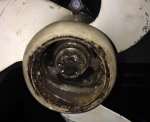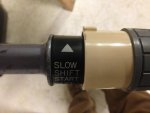chevysam41
Seaman
- Joined
- Jan 29, 2016
- Messages
- 59
Hello All,
I have a 1976 Evinrude 15hp outboard (15604A) that my grandfather bought brand new. The outboard was used and taken well care of until he passed away in 1988. After that time the outboard was dismounted from the boat and stored indoors in a dry environment. I'm trying to restore the motor to operational status. I've done many hours of research (thanks leeroy!) and have replaced the following:
* Water pump (complete)
* Lower unit oil (Hi-VIS)
* NGK B6HS spark plugs gapped to .030
* Coils
* Carb rebuilt (the slow speed needle is bent ever so slightly)
* New thermostat
* New fuel pump (and lines)
* Greased the prop shaft with triple guard
I was able to start the motor up a couple of days this week. All together, it has run for less than five minutes.
1) When the motor is idling in neutral, it produces a moderate amount of white smoke. Is this normal for a motor that has been sitting for almost 30 years?
2) The motor doesn't seem to want to idle at a normal RPM (by normal, I mean what I tend to see online for these motors). Could this be a result of incorrect A/F ratio?
3) May be a dumb question, but is the 1 1/2 turns from soft seat...seating the idle needle by hand or with the knob attached? (soft seat with the knob on is much further in the carb.)
4) I let the motor idle for about 2 minutes or so on 1/26. When I looked at it yesterday, there was a grey watery/slimey mixture in the propeller hub (see attached photo, but it isn't as thick as it looks). Is this normal?
I'm very mechanically capable and know my way around GM LSX engines, but I'm new to outboards and hoping you all can shed some light. I have a couple of videos of it running that I can post if that would help.
Thanks!
I have a 1976 Evinrude 15hp outboard (15604A) that my grandfather bought brand new. The outboard was used and taken well care of until he passed away in 1988. After that time the outboard was dismounted from the boat and stored indoors in a dry environment. I'm trying to restore the motor to operational status. I've done many hours of research (thanks leeroy!) and have replaced the following:
* Water pump (complete)
* Lower unit oil (Hi-VIS)
* NGK B6HS spark plugs gapped to .030
* Coils
* Carb rebuilt (the slow speed needle is bent ever so slightly)
* New thermostat
* New fuel pump (and lines)
* Greased the prop shaft with triple guard
I was able to start the motor up a couple of days this week. All together, it has run for less than five minutes.
1) When the motor is idling in neutral, it produces a moderate amount of white smoke. Is this normal for a motor that has been sitting for almost 30 years?
2) The motor doesn't seem to want to idle at a normal RPM (by normal, I mean what I tend to see online for these motors). Could this be a result of incorrect A/F ratio?
3) May be a dumb question, but is the 1 1/2 turns from soft seat...seating the idle needle by hand or with the knob attached? (soft seat with the knob on is much further in the carb.)
4) I let the motor idle for about 2 minutes or so on 1/26. When I looked at it yesterday, there was a grey watery/slimey mixture in the propeller hub (see attached photo, but it isn't as thick as it looks). Is this normal?
I'm very mechanically capable and know my way around GM LSX engines, but I'm new to outboards and hoping you all can shed some light. I have a couple of videos of it running that I can post if that would help.
Thanks!






















